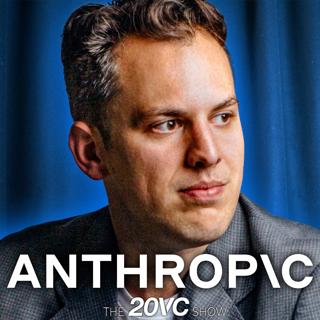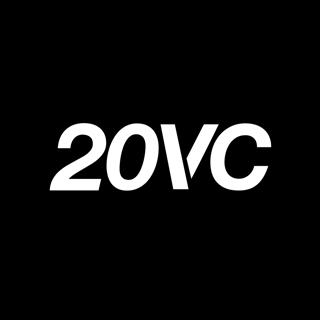
20VC: Lovable on Hitting $17.5M in ARR in 3 Months | Adding $2.1M ARR Every Week | Hitting 85% Day 30 Retention: Better than ChatGPT | The Story of Europe's Fastest Scaling Company with Anton Osika
Anton Osika is the Co-Founder and CEO @ Lovable, the fastest growing startup in Europe. With Lovable, you can turn your idea into an app in seconds with just a prompt. After just 3 months, the company has scaled to $17.5M in ARR. They are adding $2M in net new revenue every single week. Even better, Lovable has 85% Day 30 retention rate, making it more retentive than ChatGPT. In Today's Episode We Discuss: 03:41 How a Side Project Turned into a $200M Company 05:39 Why Talent is 10x More Valuable Than Experience 08:57 How to Use a Waitlist Pre-Launch to 10x Growth 12:29 How to Master a Public Launch: $0 - $1M ARR in a Week 18:02 Why Raise a Large Seed Round 22:22 How Sustainable is Lovable and AI Revenue 25:22 What are Lovable's Biggest Threats: Incumbents or Open Source 27:00 Raising Series A: Should You Always Take the Money 27:46 How to Compete in the US from Europe 28:25 Is Europe as F****** as the World Thinks 29:02 Building in Europe vs. Silicon Valley 31:20 The Future of Foundation Models: Who Wins 33:47 Grok vs OpenAI vs Anthropic: Buy and Short 41:37 Quickfire Round: Insights and Reflections
5 Mars 50min

20VC: Anthropic CPO Mike Krieger: Where Will Value Be Created in a World of AI | Have Foundation Models Commoditized | When Do Model Providers Become Application Providers | What Anthropic Learned from Deepseek
Mike Krieger is the Co-Founder of Instagram and now CPO @ Anthropic. In Today's Episode with Mike Krieger We Discuss: 03:07 Where Will Value Be Created and Sustained in a World of AI? 04:59 Are Foundation Models Commoditised Today? 08:36 Should Founders Build for the Models of Today or Build for Models of the Future 12:19: Why Will Models Become More Different Than More Similar 16:38: Will Human or Synthetic Data Be More Prominent in the Future 19:28 Model Quality vs. Product UX 23:36 The Competitive Landscape of AI 32:27 Do We Underestimate China's AI Capabilities 33:59 What Did Anthropic Learn from Deepseek 34:07 Is Deepseek a Sustaining and Credible Threat? 37:04 Transitioning from Model Provider to Application Provider 38:26 Where Has Anthropic Chronically Under-Invested 39:08 Why Has Anthropic Been Slow On Consumer Product Development 43:50 What is the Role of a Software Developer in the Future 48:29 Balancing API and Consumer Products 51:09 Is Europe Stronger or Weaker in a World of AI 52:40 Quickfire Round: Insights and Reflections
3 Mars 1h 6min

20Growth: Inside Ramp's Growth Engine: How Ramp Became the Fastest Growing SaaS Company Ever | What Worked & What Did Not Work | How to Hire for Growth | How to Find Alpha in Channels Where No One Else Can with George Bonaci
George Bonaci is the VP of Growth at Ramp, where he's helping one of the fastest-growing fintech companies scale even further. Prior to Ramp, George was VP of Growth at Gong. Before Gong, George was at Samsara where he helped grow revenue from $650M ARR, and played a pivotal role in the company's successful IPO. In Today's Growth Masterclass We Discuss: 03:57 How the Best Growth Teams Experiment 05:10 How to Allocate Bets and Resources for Growth 07:09 Velocity vs. Quality in Growth 15:05 The Role of Postmortems and How to Do Them 19:16 Growth Team Structure and Standalone or Not? 20:01 The Three Ways to Find Alpha in Growth 30:01 How to Hire for the Best Growth Hires 31:30 How to do Take-Home Assignments When Hiring for Growth 32:51 Common Pitfalls in Hiring Growth Talent 34:16 Investing in Management and Learning 42:43 How AI Changes Growth Products and Strategies 46:43 Quick Fire Round: Common Mistakes and Growth Channels
28 Feb 55min

20VC: The Insane Story of Glovo: Selling 30% of the Company for €100K | The McDonalds Deal That Saved Them | Running out of Money Three Times | Burning $1M Per Day | Being Acquired for $2.2BN with Oscar Pierre, Founder @ Glovo
Oscar Pierre is the Founder and CEO @ Glovo, the food delivery site that will get you anything you want to your doorstep. This story is insane, the company was started by Oscar 11 years ago, in their pre-seed round they sold ⅓ of the company for €100K. The company was later saved by a deal they made with McDonald's. The company nearly ran out of money on several occasions, one time the funding round came from the CEO of Rakuten who Oscar met an FC Barcelona drinks. Today, they are a part of DeliveryHero who acquired them for $2.2BN, they have delivered 1BN orders and have almost 60M customers. In Today's Episode We Discuss: 04:27 Starting with Nothing 07:30 The First Funding Round: Selling ⅓ of the Company for €100K 09:23 Marketplace Dynamics and Expansion 15:34 The McDonald's Deal That Saved the Company 18:38 Running out of Money Three Times: Fundraising Hell 25:57 International Expansion: What Worked 29:25 Lessons from Failures: What Brazil Taught Us 31:36 How to Win in Emerging Markets 32:02 The Burn Rate (Burning $1M per day) and Investor Concerns 33:29 Scaling Challenges and Competitor Threats 34:29 The Biggest BS Elements of Company Values 35:40 How I Ruined the Culture of the Company 41:14 Layoffs and Talent Management 42:06 Biggest Lessons from M&A 44:41 The Future of Quick Commerce 45:38 Acquisition by Delivery Hero 48:56 Post-Acquisition Reflections 54:47 The CEO on Trial and Facing Prison
26 Feb 1h 7min

20VC: Why Google Will Win the AI Arms Race & OpenAI Will Not | NVIDIA vs AMD: Who Wins and Why | The Future of Inference vs Training | The Economics of Compute & Why To Win You Must Have Product, Data & Compute with Steeve Morin @ ZML
Steeve Morin is the Founder & CEO @ ZML, a next-generation inference engine enabling peak performance on a wide range of chips. Prior to founding ZML, Steeve was the VP Engineering at Zenly for 7 years leading eng to millions of users and an acquisition by Snap. In Today's Episode We Discuss: 04:17 How Will Inference Change and Evolve Over the Next 5 Years 09:17 Challenges and Innovations in AI Hardware 15:38 The Economics of AI Compute 18:01 Training vs. Inference: Infrastructure Needs 25:08 The Future of AI Chips and Market Dynamics 34:43 Nvidia's Market Position and Competitors 38:18 Challenges of Incremental Gains in the Market 39:12 The Zero Buy-In Strategy 39:34 Switching Between Compute Providers 40:40 The Importance of a Top-Down Strategy for Microsoft and Google 41:42 Microsoft's Strategy with AMD 45:50 Data Center Investments and Training 46:40 How to Succeed in AI: The Triangle of Products, Data, and Compute 48:25 Scaling Laws and Model Efficiency 49:52 Future of AI Models and Architectures 57:08 Retrieval Augmented Generation (RAG) 01:00:52 Why OpenAI's Position is Not as Strong as People Think 01:06:47 Challenges in AI Hardware Supply
24 Feb 1h 12min

20VC Exclusive: Mercor Raises $100M at a $2BN Valuation: Scaling to $70M in ARR in 24 Months | 9-9-6: 9AM-9PM - 6 Days Per Week: The Most Intense Culture in Silicon Valley | The Future of Programming, Models and Data with Adarsh Hiremath
Adarsh Hiremath is the Co-Founder and CTO @ Mercor, an AI recruitment platform and one of the fastest-growing companies in technology. They have scaled to $70M in ARR in just 24 months. They are famed for working 6 days per week, 9AM to 9PM. All of their founders are Thiel fellows, they are also the youngest unicorn founders ever with the fundraise announced today raising $100M led by Felicis at a $2BN valuation. In Today's Episode We Discuss: 04:36 How Debating Makes The Best Founders 06:05 Do People Treat You Differently When a Unicorn Founder 10:58 Scaling to $70M ARR in 24 Months 13:42 How Culture Breaks When Scaling So Fast 23:49 The Future of Foundation Models 24:05 OpenAI vs Anthropic 24:32 Data: Synthetic vs Human 27:10 The Future of Programming and AI 28:15 The Impact of AI Tools on Software Development 28:51 Why Software Will Become Commoditised 29:55 Network Effects and Marketplaces 33:13 Raising From Benchmark After a Helicopter Ride 37:30 Quickfire Round: Insights and Reflections
20 Feb 45min

20VC: NVIDIA vs Groq: The Future of Training vs Inference | Meta, Google, and Microsoft's Data Center Investments: Who Wins | Data, Compute, Models: The Core Bottlenecks in AI & Where Value Will Distribute with Jonathan Ross, Founder @ Groq
Jonathan Ross is the Founder & CEO of Groq, the creator of the world's first Language Processing Unit (LPUTM). Prior to Groq, Jonathan began what became Google's Tensor Processing Unit (TPU) as a 20% project where he designed and implemented the core elements of the first-generation TPU chip. Jonathan next joined Google X's Rapid Eval Team, the initial stage of the famed "Moonshots Factory", where he devised and incubated new Bets (Units) for Google's parent company, Alphabet. In Today's Episode We Discuss: 04:20 Interview with Jonathan Ross Begins 04:59 Scaling Laws and AI Model Training 06:22 Synthetic Data and Model Efficiency 12:01 Inference vs. Training Costs: Why NVIDIA Loses Inference 17:06 The Future of AI Inference: Efficiency and Cost 18:15 Chip Supply and Scaling Concerns 20:57 Energy Efficiency in AI Computation 25:40 Why Most Dollars Into Datacenters Will Be Lost 31:05 Meta, Google, and Microsoft's Data Center Investments 41:11 Distribution of Value in the AI Economy 42:10 Stages of Startup Success 43:17 The AI Investment Bubble 45:00 The Keynesian Beauty Contest in VC 48:40 NVIDIA's Role in the AI Ecosystem 53:39 China's AI Strategy and Global Implications 57:51 Europe's Potential in the AI Revolution 01:10:14 Future Predictions and AI's Impact on Society
17 Feb 1h 20min

20VC: From Penniless Printing Shop Offices to Public Company and One of the Largest Entertainment Companies: The Story of LADbible | The Future of Content & Social Media | US vs Europe: Is Europe F****** with Solly Solomou
Founder and CEO of LADbible Group, Solly Solomou has built one of the largest and most engaged digital media entertainment companies in the world. Under his leadership, LADbible has grown to reach two-thirds of 18-34-year-olds in the UK, with a global audience of over 494 million followers, including 141 million in the US. The company's content now has a total reach of over 1 billion people worldwide. In Today's Episode We Discuss: From Printer Shop Office to Ringing the IPO Bell: How did Solly start LADbible with no money and no experience? How did a moment with Kevin Hart and Ice Cube show Solly that he had something special with LADbible? In the expansion of the business, what new products did not work? What did Solly learn from the failures of products? Why did Solly always want to build the business without an external funding? What are the top 3 pieces of advice Solly gives to young entrepreneurs starting a business today? The Future of Content and Social Media: How does Solly see wearables changing the future of media and social? Does Solly agree that the friendship graph has been eradicated by interest graphs? Does Solly think TikTok should be banned? Why does Solly think TikTok Shop is the most interesting product in social today? Europe vs US: Is Europe F******: What are the single biggest differences between doing business in the US vs Europe? Why did Solly decide to go public in London on The London Stock Exchange? How tough is it being a public company in London? How important are local liquidity markets if Europe is to regain competitiveness? If Solly were advising Keir Starmer on how to stimulate growth in the UK, what would he say and advise?
14 Feb 59min






















